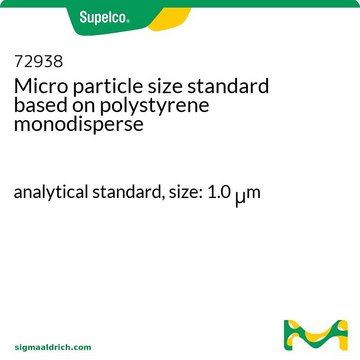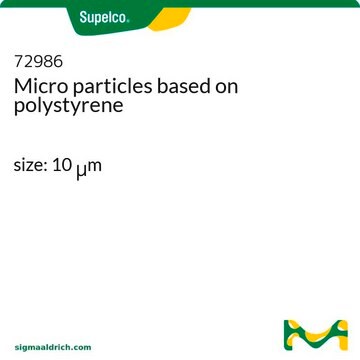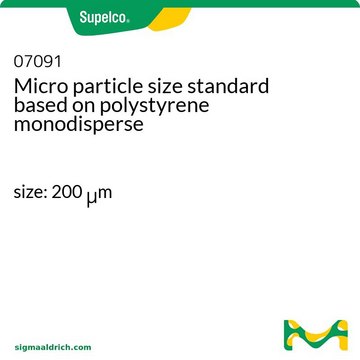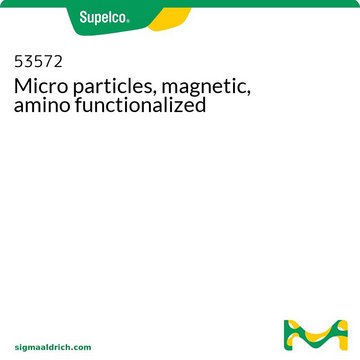59769
Micro particles based on polystyrene
size: 500 nm
Synonym(s):
Latex beads from PS
Sign Into View Organizational & Contract Pricing
All Photos(1)
About This Item
Recommended Products
Quality Level
form
aqueous suspension
concentration
10% (solids)
particle size
500 nm
density
1.05 g/cm3
storage temp.
2-8°C
Looking for similar products? Visit Product Comparison Guide
Related Categories
General description
Micro Particles or Latex Beads, commonly known as polystyrene microparticles, are negatively charged colloidal particles. The microparticles are produced through a polymerization reaction of styrene under controlled conditions. The conducive environment of the reaction induces spontaneous coalescent bead formation. Micro Particles or Latex beads are supplied in aqueous solutions composed of polymer particles with water. Polystyrene′s refractive index at 589 nm is 1.5905 and 1.602 at 486 nm.
Application
Micro Particles or Latex Beads is used for a wide variety of applications like:
- Electron Microscopy.
- Cell Counter Calibration.
- Immunodiagnostics, especially for latex agglutination tests, and
- Phagocytosis Research.
Analysis Note
For every lot exact values of particle size and standard deviation are determined with an accuracy of 0.01 μm using a Coulter Multisizer.
Storage Class Code
10 - Combustible liquids
WGK
WGK 3
Flash Point(F)
Not applicable
Flash Point(C)
Not applicable
Personal Protective Equipment
dust mask type N95 (US), Eyeshields, Gloves
Choose from one of the most recent versions:
Already Own This Product?
Find documentation for the products that you have recently purchased in the Document Library.
Customers Also Viewed
Shunmugaperumal Tamilvanan et al.
PDA journal of pharmaceutical science and technology, 62(3), 177-190 (2008-07-30)
The objective of this study is to select a multiple-unit sustained-release formulation and to compare it with both commercial immediate and single unit sustained-release capsules and also to determine whether an in vitro-in vivo correlation exists for single- and multiple-
Elizabeth M Walker et al.
Journal of colloid and interface science, 363(1), 307-313 (2011-08-16)
We have studied polydimethylsiloxane (PDMS)-in-1-butyl-3-methylimidazolium hexafluorophosphate ([BMIM][PF(6)]) Pickering emulsions stabilized by polystyrene microparticles with different surface chemistry. Surprisingly, in contrast to the consensus originating from oil/water Pickering emulsions in which the solid particles equilibrate at the oil-water droplet interfaces and
Fiona A Sharp et al.
Proceedings of the National Academy of Sciences of the United States of America, 106(3), 870-875 (2009-01-14)
Many currently used and candidate vaccine adjuvants are particulate in nature, but their mechanism of action is not well understood. Here, we show that particulate adjuvants, including biodegradable poly(lactide-co-glycolide) (PLG) and polystyrene microparticles, dramatically enhance secretion of interleukin-1beta (IL-1beta) by
Sensitive Mie scattering immunoagglutination assay of porcine reproductive and respiratory syndrome virus (PRRSV) from lung tissue samples in a microfluidic chip.
Song JY, Lee CH, Choi EJ, Kim K, et al.
J. Virol. Methods, 178, 31-38 (2011)
Our team of scientists has experience in all areas of research including Life Science, Material Science, Chemical Synthesis, Chromatography, Analytical and many others.
Contact Technical Service










